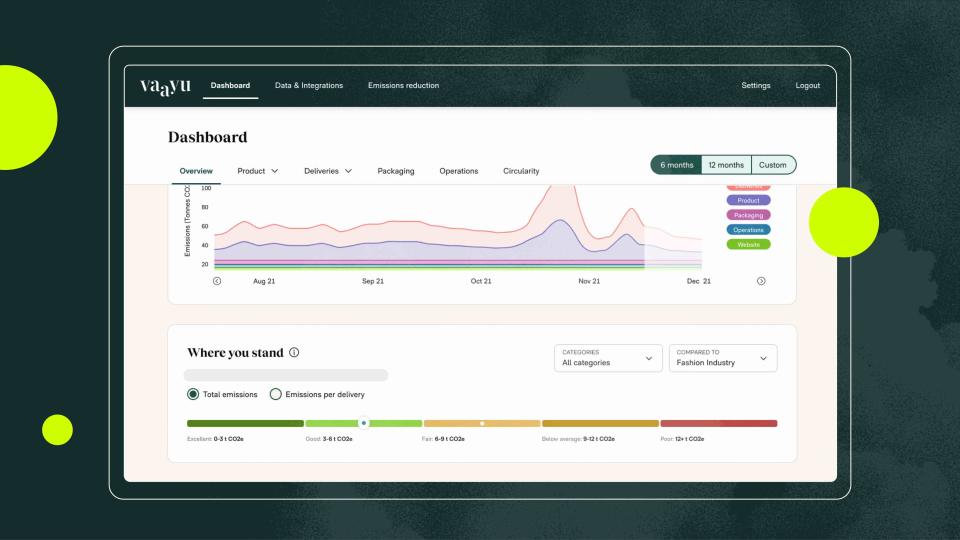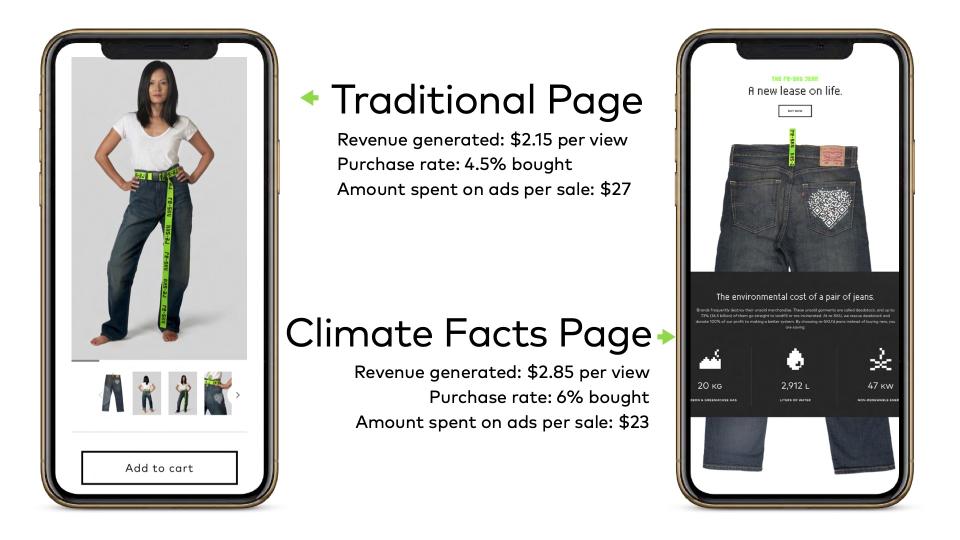Imagine Real-Time Sustainability Data Printed on Garments Just Like Nutritional Facts

Wouldn’t it be nice if just as every piece of food has nutritional facts printed on its packaging, every piece of apparel wore its sustainability information, too? And wouldn’t it be nice if those facts could be updated in real-time using metrics the common consumer could easily understand?
If technologies from a pair of startups—one at Penn State University and another in Berlin—are able to take hold, both concepts could become everyday realities in a more environmentally accountable future.
More from Sourcing Journal
The first idea belongs to re-SKU, which, behind the motto “Products with heart,” produces QR codes in the shapes of hearts, that when scanned reveal “Climate Facts” that read like a scoreboard with details of kilograms of greenhouse gasses produced and liters of water used to create a letter grade. Put the scores together and the product stamped with the digital heart gets one concise “Climate Score.”
“So this is inspired, obviously, by nutrition facts, but for us, the critical thing is that it’s actually leveraging state-of-science technology to measure those liters of water and kilograms of greenhouse gas emissions,” Eli Andrews, re-SKU’s co-founder, told Sourcing Journal. “There’s got to be something that cuts through the noise with a signal and we want to help create that signal.”
Andrews hopes someday re-SKU’s little green hearts are found on products on shelves and e-commerce catalogues everywhere, but for now the startup’s focus is on consulting with businesses that are trying to learn and lessen their true footprint.
“Right now what we want to do is help corporations become champions in the fight against global warming,” Andrews said. “Whether that’s because there’s regulation coming and they want to comply or because they actually, you know, give a shit or whatever, wherever they’re from we’re gonna meet them where they’re at and just give them the science.”
The science, Andrews said, comes from a handful of sources, including openLCA, an open-source life cycle analysis database to formulate its scores, as well as a lesser-used, more academic database known as Eora, semi-public sources such as the Carbon Disclosure Project, and primary sources, i.e., information from the businesses themselves.
Part of the problem with applying this information, apart from any objections brands getting low grades, might have about the validity of the data, is ensuring the data is current.
“Even if you want to, say, put this on Levi’s 501 jeans, the problem is it’s a dynamic and shifting thing. A batch from two years ago is not going to have the same footprint as a batch from this year, and yet, there might be multiple of those on the same rack, next to each other,” Andrews said. “So is it achieveable? Yes, but this is enormously complex. It needs algorithms and multiple databases and individual inputs from the company, so we wouldn’t publish that until we had done all those things.”

Namrata Sandhu has some ideas about improving the timeliness of carbon calculators for some time.
Three years ago she started up Vaayu, a carbon calculator based in Berlin that can track footprint hour-to-hour, the only of its kind presently offering that, she believes. Time Magazine named the software one of 2022’s Best Inventions.
“I think on specific days, like Black Friday, it starts to become interesting because you want to understand very quickly the impact,” Sandhu told Sourcing Journal. “The idea is to think about carbon the same way you think about other analytics… Businesses need to use the same lens to think about carbon the same way it thinks about sales numbers.”
Sandhu said that current carbon calculator models review the previous 12 months, a delay that just can’t stand in the world that is to come. That’s one of the gaps in the current state of carbon calculation that motivated the former KPMG, Zalando and Arcadia Group sustainability executive, originally from Mumbai, to start-up Vaayu. The other gap she’s looking to fill is helping businesses make responsible decisions when it comes to everything from choosing their packing type, to what dyes to use and which third-party logistics partners to work with.
“You can see the kind of routes, you can see the orders and how much carbon is generated by what products got sold,” Sandhu said. “We have very detailed analytics on basically everything that’s happening, so you can quantify, in carbon, as to what the total of that impact has.”
While Sandhu’s company stands apart as the lone company offering real-time updates, re-SKU boasts that it is the only carbon calculator that also measures the water usage of every product.
“The two things that set us apart is that we’re using multi-layer network science that is algorithmically tracing every drop of water and every kilogram of carbon—that is rare,” Andrews said. “It’s not that we’re the only people doing extra carbon; we are, as far as I know, right now the only people doing it for carbon and water.”
Andrews said re-SKU also distinguishes itself by not relying on averages alone, as does the well-known Higg Index. Going beyond averages, Andrews says, means working closely with suppliers, like one of re-SKU has been in talks with that is part of Walmart’s Project Gigaton, meant to reduce “beyond-the-shelf” greenhouse gasses emitted by its suppliers and prevent the planet from reaching the one-gigaton carbon threshold by 2030.
“We can do averages using the collections of three databases (openLCA, Eora, Carbon Disclosure Project), and that’s a lot better than most of what’s out there now, but where you really get to go beyond the averages and cracking a real supply chain is when you’re working with a company and they’re saying, ‘we’re sourcing our cotton from over here; we’re getting the metals from over here, our plastics from over here,'” Andrews said. “So we know how far it’s traveling because, you know, each component of something like a pair of jeans actually has its own complete, super-complex supply chain.”

re-SKU, named for the alphanumeric code common to just about all stock-keeping, also tries to show its clients that being transparent in the Climate Facts page will result in more profit per advertising dollar spent. This was part of its business model when it launched as a DTC brand, but now the self-funded startup is looking for a handful of major clients and venture capital for a robust initial launch.
“This tech has been built by researchers here at Penn State who have been building these algorithms and these databases, mostly for academic use,” Andrews said. “They want to get it out into the world and so we’re helping with that as well, making this make sense for businesses and helping businesses make money and do good.”
Vaayu is further down the road with clients of its own, including Lithuania-born Vinted, Europe’s top C2C marketplace for second-hand clothing. Vinted put out a report in March that 350,000 shoppers buying second-hand on Vinted, rather than new, prevented 453 kilotonnes of CO2 from being released into the atmosphere. That’s the equivalent, the company said, of flying from London to Los Angeles and back 275,000 times.
“Fashion is responsible for significant damage to the environment, so our mission is grounded in the conviction that resale is one of the solutions to tackle this harm,” said Thomas Plantenga, CEO of Vinted.
In performing the study, Vaayu surveyed 350,000 Vinted users because, Sandhu said, there is no base set of data available to determine whether a seller was actually replacing new product or just selling more used product.
“The other big piece is Vinted’s own operations and delivieries,” Sandhu said. “We used more than half a million transactions of live data to understand where the things move around, looking at Vinted’s own operations, the deliveries and replacement rate and a lot of other details.”
Vaayu has also partnered with Klarna, the Swedish-based credit card-alternative, to expose Klarna’s 150 million consumers to sustainability information about all of their purchases.
Klarna justified that intrusion by conducting a comprehensive survey of 17,218 of its own customers from 17 countries in the early part of this year, and on the question of sustainability found that 57 percent of customers are looking for ways to track their carbon footprint while shopping.
“The data couldn’t be clearer—more and more shoppers demand transparency into the environmental impact of their purchases,” said Klarna’s head of sustainability Salah Said. “But in order for consumers to make considered choices, they require unbiased and reliable information that they can understand.”


